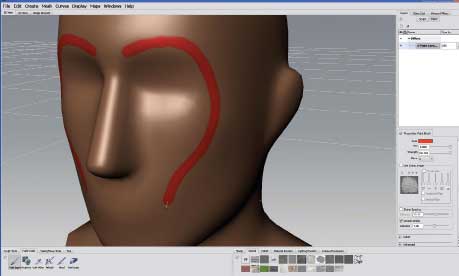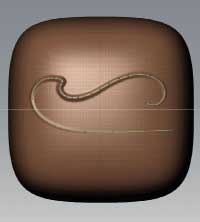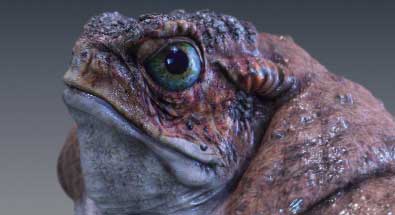Autodesk Mudbox: Sculpting in Digital Clay
While some 3D applications provide organic sculpting as an adjunct, Autodesk's Mudbox places sculpting front and center.
December 7, 2009
By Mark Clarkson
 Figure 1: Steady Stroke averages and smooths out your brush strokes, eliminating jitters. |
Mudbox’s working metaphor is sculpting with digital clay, and it’s almost as intuitive and practically as easy to use. My 10-year-old son had no trouble sculpting a low-resolution head into a hideous monster after about 15 seconds of instruction.
Mudbox’s very clean default workspace consists of a single, large camera view with tool palettes below and to the side. There’s no way to create a split view (e.g., Front/Side) Mudbox does, however, permit using camera bookmarks or using separate cameras to switch between different views of a model.
To get to work, just plop down your lump of clay and start sculpting. You work by adding clay and scraping it off, or by pushing and pulling on it. If you’re using a tablet (e.g., a Wacom), Mudbox’s brushes are pressure sensitive.
The Tools
Mudbox gives you 19 sculpting tools including Sculpt, Smooth, Pinch, Scrape, Fill, Flatten, which, for the most part, do exactly what you think they will.
All brushes allow you to mirror your strokes across any axis to easily model symmetrically. Pressing Ctrl (or checking Invert in the brush’s properties) inverts the direction of most brushes “Bulge creates cavities instead of bulges, for example. Pressing Shift temporarily changes any brush to the Smooth tool, which blends features together.
You can change the shape of a brush by modifying its falloff, or by adding a bitmap stamp. The stamp’s grayscale values control the strength of the tool, making it easy to apply lumps, bumps, and other textures.
Paint on your meshes with paintbrush, pencil, or airbrush to create color maps, bump maps, specular maps, and so forth. You can export these maps for use in other applications, or for fine-tuning in Photoshop.
You can also paint masks, which constrain the area of effect for the sculpting and painting tools.
 Figure 2: Mudbox lets you sculpt and paint along curves to accurately trace shapes. |
Smoothing Out the Strokes
In case your hand isn’t especially steady “and mine isn’t “Mudbox gives you a couple of aids. The first is Smooth Stroke, which averages your mouse or pen movements to remove inadvertent jitters. You can adjust the amount of smoothing applied, or turn the feature off entirely.
Mudbox also lets you sculpt and paint along curves. Curves can be simple circles, squares, or lines, or they can be custom curlicues drawn with Mudbox’s basic pen tool. Brush strokes will snap to the curves, allowing you to trace and re-trace particular shapes.
Even with these aids, there’s a limit to how accurately you can carve things; you’re never going to get Class-A curves, or anything like them, out of Mudbox.
Levels and Layers
You can change the resolution of a mesh, either up or down, with a keystroke. Even very dense meshes, with tens of millions of polygons, transformed and displayed smoothly on my system.
Mudbox sports layers, similar to Photoshop’s. When you sculpt or paint, your strokes are applied to the active layer. (The meshes themselves are not tied to any particular layers.)
Let’s say I sculpt grooves into my toothbrush model on Layer 2. I can hide Layer 2 to eliminate the grooves, or lower the opacity of Layer 2 to reduce the grooves, or even invert Layer 2 to turn the grooves into ridges. All this is independent of other features, which are sculpted on other layers.
Issues of Scale
Mudbox provides a very few simple starting shapes: cube, sphere, head, tree stump. If that doesn’t suffice “and it probably won’t “you can import objects in .OBJ format, which is supported in most modern modeling applications.
There’s some by-guess-and-by-gosh involved, both in importing objects and in getting the right settings for brush strength and size. Part of it is that there’s no indication of just what scale I’m working at in Mudbox. Is that head a meter long? A kilometer? My brush size is set to 3.75, but 3.75 what? The UI gives you no indication. There is no measurement tool. You can set the linear units to, say, centimeters and then you’ll have to remember that 3.75 means 3.75 centimeters, but it would be nice to have some onscreen feedback.
This may seem irrelevant, and it might be, except that Mudbox is obsessed with scale. If you import an item at too small a scale, for example, you simply can’t work with it; the range of brush size and strength are totally inappropriate. Worse, Mudbox seems to become confused about surface normals. No problem, you say; I can just scale the mesh up. And you can, but for some reason that doesn’t resolve the problem. To actually fix things, I had to re-export my models at a different scale.
What scale? Exactly. We’re right back where we started.
An actual-size object might be too large (a truck) or too small (an MP3 player) for Mudbox to accommodate. It will take a little experimentation to establish your best workflow.
 Mudbox’s impressive real-time renderer supports HDRI image-based lighting, ambient occlusion, and depth of field (if your card is new enough). |
Rendering
Mudbox’s real-time renderer is impressive; it supports HDRI image-based lighting, ambient occlusion, and depth of field (if your card is new enough).
Still, the application has no beauty renderer, and no animation. If you need print-quality final art, you’ll have to use another package such as Maya or Max to do the rendering. You can export your sculpted meshes either as high-resolution poly meshes (OBJ), or as displacement maps to be applied to low-resolution meshes in another package.
INFO Mudbox 2009 Does clay sculpting have a place in your workflow? That’s up to you to decide. Download a trial version here. |
Limited to Concepts
Yes, I have quibbles. Mudbox is for sketching, playing around, and trying out crazy ideas. Personally, I don’t foresee many Mudbox designs going straight to manufacturing. I expect you’ll have to rebuild the geometry from scratch in another package.
Those of us accustomed to more full-featured 3D or CAD applications will run into lots of unexpected limitations. You can have multiple meshes in a scene, for example, but I can find no way to duplicate a mesh. And copying attributes “say, scale and rotation “from one mesh to another is problematic. So creating multiple buttons on an MP3 player, or two identical eyes in a human head, is much, much harder than it should be.
Mudbox’s $745 price tag, and its sheer fun and ease-of-use, though, go a long way toward making up for its shortcomings.
Contributing Editor Mark Clarkson is DE’s expert in visualization, computer animation, and graphics. His newest book is Photoshop Elements by Example. Visit him on the web at markclarkson.com or send e-mail about this article to [email protected].
Subscribe to our FREE magazine, FREE email newsletters or both!
About the Author
Mark ClarksonContributing Editor Mark Clarkson is Digital Engineering’s expert in visualization, computer animation, and graphics. His newest book is Photoshop Elements by Example. Visit him on the web at MarkClarkson.com or send e-mail about this article to [email protected].
Follow DE





